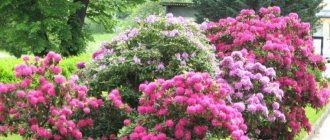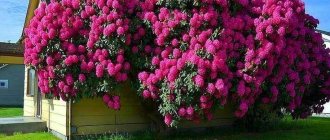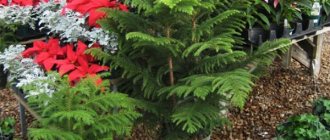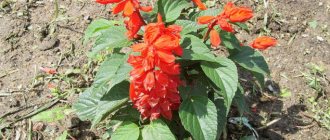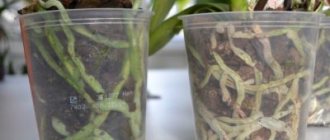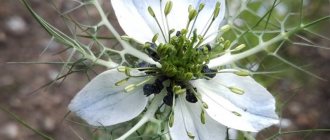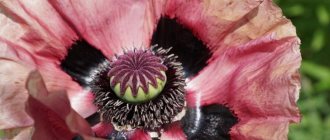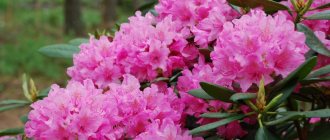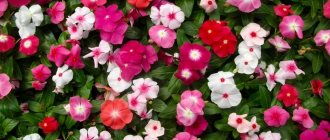Description of rhododendron
Rhododendron belongs to the heather family, which includes evergreen plants, shrubs and trees that completely or partially lose their leaves at certain times of the year. The most famous and widespread are azaleas grown indoors, in greenhouses and greenhouses.
It grows in the subtropics and temperate zone of the Northern Hemisphere, although it is also found in the Southern Hemisphere. There are 18 known species in Russia, which are distributed in the Caucasus, Siberia and the Far East. They grow singly or in groups forming entire thickets, in the mountains or under trees in the forest, in swampy areas or in the tundra. The place should be shaded and moist, but water should not stagnate in the soil. There is dampness in the air.
Types of rhododendron vary in height (from 10-20 cm to 30 m) and in flower size (several mm and more than 20 cm). Simple and compound leaves with different edges. Bisexual flowers with a corolla of different colors: lemon, pink or purple-violet. They are combined into simple and complex inflorescences, and are extremely rare alone. The fruit is represented by a five-leaf capsule that opens downwards. The seed resembles a stick 0.5-2 mm. Numerous small roots are located on the surface. Characterized by slow growth. Can be propagated in various ways.
Rhododendron is a poisonous plant containing andromedotoxin. This substance first has an stimulating effect, and then a depressant effect, leading to death. Tannins are present in the bark and leaves.
Main characteristics of the plant
Rhododendrons have the following characteristics:
- Depending on the variety, they bloom from April to June . This process may be repeated in rare cases (August - September). On average, the flowering period lasts about 16–20 days. In some species it is longer - up to a month;
- The flower is quite cold-resistant and relatively winter-hardy . The place where rhododendrons grow in nature is the northern mountain slopes, abundantly covered with snow, protecting the plants from frost. In garden plots, during cold, snowless winters, additional covering of shrubs with special material is required. This primarily applies to evergreen representatives;
- these are moisture-loving plants . They grow well in conditions of average humidity. The level of this indicator can be adjusted by planting in a shaded area, spraying the crown and frequent watering;
- Rhododendrons are symbiotic crops. Hyphae of mycorrhizal fungi form on their roots, which help plants absorb nutrients from the soil. These fungi require access to air, so the root system of rhododendrons is quite compact and located close to the soil surface. “Home” specimens have somewhat more powerful roots.
Types and varieties of rhododendron
Typically, shrub varieties are grown in gardening.
| View | Description of the bush | Sheet | Flower |
| Deciduous | |||
| Daursky | Medium with great branching. Early flowering. Steel-colored bark, thin reddish-brown shoots with slight pubescence. | Elongated, green, lemony in autumn. 5 cm | Purple-pink in the shape of a funnel. |
| Kamchatsky | Miniature in the shape of a hemisphere. Dwarf. | Large, ovoid. 5 cm | Bright carmine. Inflorescence of 3 pcs. with a velvety surface. |
| Canadian | Low, compact up to 1 m. Twisty, thin strong branches. | Elliptical, bluish-green. | Pink-lilac. The heavily cut petals resemble a moth. |
| Evergreens | |||
| Caucasian | Creeping shoots up to 1.5 m. Dark brown bark. | Dark green, smooth above and hairy below. | Fragrant, yellow with green specks or white. Bell shape. Brush of 8-12 pcs. |
| Smirnova | Young branches have slight white pubescence, old branches have gray bark. up to 1-2 m. | Oblong-elliptical 8-10 cm. | Purple in the form of a bell. |
| Adams | Branched 0.5 m. Shoots covered with glandular hair. | An elongated ellipse, bare above, with scales below. Ginger. | Various pink shades. Corymbose inflorescences 7-15 pcs. |
| small-leaved | Beautiful, compact. Young branches are rusty in color, old ones are steel. Straight or creeping. 0.5-0.6 m. | Oblong-lanceolate. | Golden 3 cm. |
Selection of seedlings
Unfortunately, nurseries don’t always produce perfect seedlings, but what should you really avoid and what should you not be afraid of? Before purchasing, you should pay attention to the following important points: • There should be no knob-like growths near the root collar, and in the crown there should be no drying out dark stems with curled leaves. • Leaves should be dark green, without spots (gray, brown, black) and signs of chlorosis (yellowing of the leaf blade, in which the veins remain green).
Planting rhododendron
In order for rhododendron to grow on a site, it needs to choose a suitable place, prepare the soil and properly plant and care. Deciduous species require a lot of light, while evergreen species require shade. All of them require shelter from the wind, and in winter from snow, so it is better to plant them near buildings, fences or tall plants. Trees that have the same structure of the root system are not suitable as neighbors: birch, spruce, maple and others. They can grow near oak, pine and fruit plants: apple, pear, cherry.
Rhododendrons prefer loose, acidic soil (4.5-5.5 pH), which freely provides access to air and water (does not linger). Sandstone and loams are deoxidized by adding peat, compost, pine needles, and bark.
Bushes at the age of 2-3 years are transplanted into a recess of 30x30 cm, older ones - into a recess of 60x40. A drainage made of crushed brick or large gravel is placed on the bottom, a special mixture of soil, peat, rotten pine needles, sand, compost (humus) is placed on top and it is well moistened so that it settles. The roots of the plant are placed in water and kept in it until the air bubbles disappear. The depth level is 3-4 cm above the root. After planting, the soil is moistened and mulched with a mixture of peat, sand and crushed pine bark.
Application in landscape design
Deciduous rhododendrons prefer to grow in a group, which may include more than three plants. This feature of Heathers is used in the process of creating single-species clumps, decorative corners, shrub mixborders, edges, using various combinations of crop varieties. It is advisable to place group plantings near a wall, path and on an open lawn. When planting plants, consider the height of adult bushes of different varieties for their successful combination.
Important! When planting bushes in a group, follow the recommendations regarding the required distance between individual plants, which should be at least 70 cm and no more than two meters.
Rhododendrons love moisture, which is why they are often used to decorate artificial ponds and fountains. Bushes look great in combination with bulbous plants . It is not uncommon to see several ferns and hostas near rhododendrons. In accordance with the soil requirements, the bushes are planted with various coniferous trees and shrubs, as well as with plants of the Heather family. Large stones are often added to landscape compositions.
Rhododendron care
Care for the plant following the rules:
- Water depending on the weather and drying of the soil. At the beginning of development, sufficient moisture with soft water is required: in summer - 1-1.5 buckets per mature plant 4 times a month, in hot weather - more often. When it gets cooler, less often - every 1.5 weeks. Water with acidified water (10-15 g of oxalic or citric acid per 10 l).
- Feed with mineral fertilizers. In the spring to revive the plant and begin its flowering. In the summer, to speed up the growth of shoots and the formation of buds for the next year. In autumn (without nitrogen) - to prepare for winter.
- Prune in the spring, removing dry and diseased shoots. You can shorten those branches that disrupt the shape of the bush. Withered flowers are torn off, otherwise the plant looks sloppy. It is necessary to direct energy to the growth of new branches and flowers.
- Transplanted at any age. It is best before the sap begins to flow - in the spring, later - after flowering or at the very beginning of autumn, so that it has time to get stronger before the beginning of winter.
- A winter-hardy plant, but it is better to cover it during the cold period.
The main problems with the underground part of the flower
When growing any plants, it is important to adhere to two rules: do not overwater and do not overdry.
Rhododendrons have a very sensitive root system that quickly absorbs water like a sponge, so watering must be constantly monitored and the soil moisture checked. Due to the formation of mycorrhiza, the underground part of the azalea grows greatly, so it is important to select a pot of suitable size . If the growing container is too small, the roots are cramped, air does not reach them, and rotting and souring occurs.
Reproduction
There are several methods of propagation: seeds, dividing the bush, layering and cuttings.
The seeds are sown shallowly in a bowl filled with a damp mixture of peat (heather) soil and sand in a 3:1 ratio. For a greenhouse effect, cover with glass or cellophane and place in the light. Aerate, irrigate and remove condensate daily. Shoots will appear in 30 days. Transplant the seedlings into another container after two leaves appear (diagram 2x3 cm). In the garden - for the 2nd year, and before that they are grown in a greenhouse. Flowers will appear at the age of 6-8 years.
A cutting is prepared from a part of the stem (5-8 cm) with unripe wood and leaves. The lower leaves are torn off and dipped in a stimulant solution for half a day. Then they stick it into the soil (peat and sand 3:1), on top - a jar or bag so that the roots grow (1.5-4 months), after which a container with soil is needed (peat and pine needles 2:1). In winter, place it in a room with +8...+12 °C and flooded with light. In spring and summer they are transferred to the garden, to the final site - after 2 years.
The easiest way to propagate is by layering: a flexible branch is bent into a groove (15 cm), secured with wire and covered with soil. The top is tied to a pole. The care is normal. In autumn or spring you can separate it from the main plant and replant it.
Divide the bush into parts, which are planted separately. In a year, young branches will appear and flowering will begin.
Growing from seeds
At home, you can grow rhododendron from seeds as seedlings for future transplantation into the garden. It is advisable to sow in mid-February - early March, then the plant will not require additional artificial lighting. Pink trees sown in December - January need to be illuminated due to the short daylight hours. For these purposes, incandescent lamps or special phytolamps designed for seedlings and indoor flowers are used.
Seed material can be collected independently, purchased from a nursery, or purchased from a botanical garden. Rhododendron seeds are rarely found in flower shops.
Selecting a landing container
Before sowing, it is necessary to choose the right planting container for rhododendron. The height of the container should not exceed 5 - 7 cm. For planting, you can use plastic cups, small flower pots, wooden boxes or containers from the supermarket. It is necessary to make drainage holes at the bottom of the container to remove excess moisture during watering. Peat tablets and pots are used as planting pots, together with which the plant is transplanted into open ground so as not to injure the root system.
The selected container must be disinfected to get rid of pathogens and fungal infections. Previously used pots must be cleared of old soil and washed.
It is not recommended to carry out disinfection with products containing chlorine, for example, “Belizna”. The containers are poured generously with boiling water or soaked in a solution of potassium permanganate. Place peat tablets in a heat-resistant container, pour boiling water over them and cover with a lid for several hours.
Soil preparation
To ensure normal growth of rhododendron seedlings, it is important to properly prepare the soil.
The soil must contain the following components:
- 1 part peat;
- 1 part sphagnum or coniferous decline;
- 0.5 parts sand.
A drainage layer of crushed expanded clay, fine granite gravel or broken red brick 1–2 cm thick is laid on the bottom of the planting container.
Each component of the soil mixture must be sterilized in the oven at a temperature of +180...+200 degrees for 1 - 2 hours, then cooled and placed on top of the drainage in a planting container.
The soil is shed generously with settled or rainwater so that all components of the soil mixture are saturated with moisture. To ensure uniform soaking, the containers are placed in a container of water so that the water reaches half the height of the pots.
Sowing
Sowing rhododendron seeds is carried out on the surface of the soil. Seeds buried or covered with soil will not sprout.
Seed material is laid out on moist soil or on the surface of peat tablets at a distance of 3–5 cm from each other. Then the soil is sprayed with a spray bottle. The surface must be moistened carefully so that the seeds do not move and sink into the soil substrate.
The planting containers are covered with cling film. Plastic cups or peat tablets can be placed in a mini-greenhouse made from transparent plastic boxes or other containers, over which film is stretched or glass is placed. To protect the seedlings from drying out, you can lay wet sphagnum on the bottom of the greenhouse.
After sowing, the soil should not be allowed to dry out; the soil should be moderately moistened with a spray bottle, avoiding stagnation of water in the container.
Planting containers are kept at room temperature (+18…+22 degrees) away from direct sunlight and heating appliances. Shoots will appear 12–20 days after sowing.
The selection of seedlings into large containers or open ground is carried out in mid-May, when the threat of frost has passed. For hardening, containers are taken out into the open air in warm weather and placed in semi-shaded areas. Plants can be protected from direct sunlight by covering them with a lattice plastic box.
Young seedlings are covered with spruce branches or dry oak leaves for the winter. On top of the plantings, boxes are placed upside down, on which lutrasil is laid.
Diseases and pests
Rhododendron is susceptible to attack by certain pests and a number of diseases.
| Pest | Symptoms (on foliage) | Elimination measures (spraying) |
| Rhododendron bug | Small white markings. Below are insect eggs (brown). | Diazinon. |
| Asian garden beetle | The hole is irregularly shaped or only veins remain. | |
| Mealybug | Wrong shape. Death. | Karbofos. Repeatedly. |
| Grooved weevil (fluted weevil) | The edges are damaged, the bark near the root is eaten away. | 0.3% karbofos emulsion, for irrigation 0.2-0.3%. At the end of summer, 0.1-0.15% liquid Bazudin or diazinon and Furadan are used. |
| Spider mite | Below is a thin web. Steel brown color. They fly around. | Agravertine, diazinon. |
| Tillable slug | Through holes appear very quickly. | 0.8% TMTD. Collection of adult specimens. |
| Black thrips | Gray holes on top, dark ones on bottom. Steel tint, shedding. The inflorescence is ugly. Development is slowing down. | 0.2-0.3% nicotine. 0.2% karbofos emulsion. |
| Narrow-winged miner moth | The surface is stained. They curl into a tube, dry out, crumble and crumble. | Spraying or fumigating with sulfur. |
In addition to pests, rhododendrons are susceptible to some diseases.
| Manifestation on leaves / Symptoms | Disease / Causes | Corrective measures |
| Yellowness. Curling, drying out. Flowering is weak. | Mixed chlorosis. There are not enough batteries. Stagnant water, dense soil around the root system or has become alkaline. | Foliar feeding with iron salt of sulfuric acid 7.5 g/l, magnesium 6.5 g/l. |
| Red spots, curling, drying out. | Sulfuric acid salt or ammonium nitrate. Potassium nitrate. | |
| Brownish on top. | Necrosis. Reducing the ambient temperature. | Cover. |
Each case of disease requires identification of the causes and their elimination.
The role of the organ in the life of a plant
For plant life, only moisture, light and inorganic substances are needed. Roots are responsible for:
- water absorption;
- absorption of nitrogen, phosphorus, potassium and trace elements.
Mycorrhizal fungi are an additional protection against infections and a source of antibiotics. Without them, the plant grows weakened or becomes completely unviable.
In perennials, the root system helps to survive unfavorable periods. Even if the above-ground part dies completely, the plant can recover from root buds.
The benefits and harms of rhododendron
Rhododendron is used to decorate areas, but it has useful qualities that are used in conventional and folk medicine. The presence of vitamin C, andromedotoxin, ericolin, arbutin and rhododendrin led to its use:
- will help reduce fever and pain;
- will have a calming and bactericidal effect;
- relieve swelling;
- removes excess fluid from the body;
- will lower the pressure.
Contraindications: pregnancy, breastfeeding, kidney disease and tissue necrosis.
It is best to carry out treatment in consultation with a doctor. This will protect you from unwanted consequences or death, which is possible because many species are poisonous.
What could cause her to die?
Prolonged stagnation of water is detrimental to the root system. Especially at temperatures below 18 degrees. In a damp and cold environment, harmful bacteria and fungi actively develop, which infect the underground part of the plant and destroy it (read about azalea diseases and pests here).
Important. Improper replanting can also lead to root death. It is impossible to completely wash out the soil from the underground part, overdry it and treat it with broad-spectrum fungicides. This is detrimental to mycorrhiza.
Features of care and planting in the Moscow region
The main thing is to choose the right species that can withstand the Central climate well. Rhododendrons suitable for the Moscow region:
- Vaseley;
- Tree-like;
- Daursky;
- Yellow;
- Golden;
- Ledebura;
- Kamchatsky;
- Canadian;
- Katevbinsky;
- Short-fruited;
- Pukhansky;
- Protistum;
- Rusty;
- Smirnova;
- Schlippenbach;
- Japanese.
Japanese salmon variety
Information about zoned varieties and hybrids can be obtained upon purchase.
The plant is planted in the Moscow region in the spring - the bush will have time to take root before winter. Choose a semi-shaded place, protected from cold winds. At the end of the season, rhododendron must be mulched and covered with non-woven material. The rest of the care is the same as described above.
